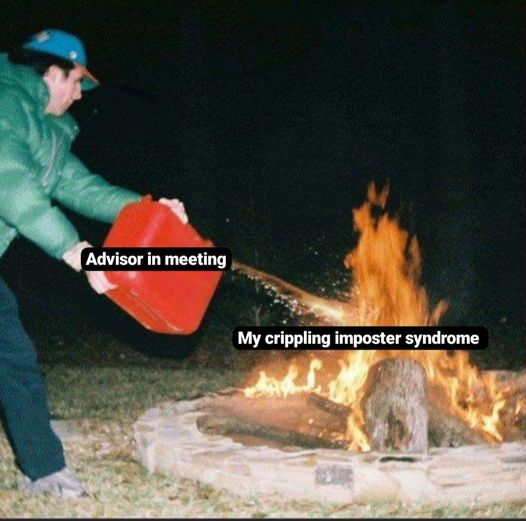9.5 Imposter Phenomenon & Imposterism
Gemma Smyth and Andrew Pace
Imposterism and Imposter Phenomenon
Introduction
For some students, entering a legal workplace for the first time can trigger a host of feelings including anxiety and fear. This is often a moment where students, lawyers and others begin identifying feelings of what is often referred to as “imposter syndrome”. Feelings of dread, feeling “out of place”, not fitting in, feeling like someone made a mistake in hiring you, or waiting to be “found out” starts eating away at one’s sense of wellbeing and competence. These and other feelings have been termed by many as “imposter syndrome”.
Imposterism at Work
Journalist Sheryl Nance-Nash wrote,
“Although I haven’t worked in an office in more than 20 years, I still remember the feeling I used to have at my nine-to-five magazine job. No matter how well I did, I always felt that I wasn’t good enough for the rarefied publishing world. I didn’t come from a pedigree; I just was a hard-working black woman. I felt (and sometimes literally was) unacknowledged in the hallways, and my voice was hardly heard. It wasn’t unusual that ideas I presented at meetings got a lukewarm reception, but two meetings later someone else suggested a similar thought, which was instantly deemed a must-write story.
Even though I knew I was capable of doing the work, I was riddled with doubt. It was years later that I learned there was a term for what I felt: imposter syndrome.
This text uses the term imposter phenomenon and imposterism rather than imposter syndrome. Imposterism is not a diagnosable illness and is not identified as a psychiatric disorder. There are many definitions of imposterism, but they commonly highlight a few key elements. Bravata et al describe sufferers as follows: “despite their objective successes, [people] fail to internalize their accomplishments and have persistent self-doubt and fear of being exposed as a fraud or imposter.” Imposterism is a feeling of inferiority in which people feel they might have achieved success by accident, or that they are “a fraud”. Like in the example above, feelings of imposterism can be triggered or exacerbated by actions of colleagues. Imposterism may be experienced by many people, but it is reinforced by systems.
Instagram, @Litigation_God, 2022.
There are many practical tools to help address imposter syndrome or imposter phenomena. See “How to Overcome Imposter Syndrome: 14 Tests & Worksheets”, or speak with a mental health counsellor or career coach. As we explore in the next section, however, “imposter syndrome” should also be seen as a systemic rather than individual problem.
Problematising Imposter “Syndrome”
Ruchika Tulshyan and Jodi-Ann Burey note the problematic aspects of the idea of “imposter syndrome”. As they write,
“Imposter syndrome,” or doubting your abilities and feeling like a fraud at work, is a diagnosis often given to women. But the fact that it’s considered a diagnosis at all is problematic. The concept, whose development in the ‘70s excluded the effects of systemic racism, classism, xenophobia, and other biases, took a fairly universal feeling of discomfort, second-guessing, and mild anxiety in the workplace and pathologized it, especially for women. The answer to overcoming imposter syndrome is not to fix individuals, but to create an environment that fosters a number of different leadership styles and where diversity of racial, ethnic, and gender identities is viewed as just as professional as the current model.”
Rather than self-blame, Tulyshan and Burey refocus on the institutions that do not make people feel safe or welcome. As they write,
“In truth, we don’t belong because we were never supposed to belong. Our presence in most of these spaces is a result of decades of grassroots activism and begrudgingly developed legislation. Academic institutions and corporations are still mired in the cultural inertia of the good ol’ boys’ clubs and white supremacy. Biased practices across institutions routinely stymie the ability of individuals from underrepresented groups to truly thrive.”
The answer to overcoming imposter syndrome is not to fix individuals but to create an environment that fosters a variety of leadership styles and in which diverse racial, ethnic, and gender identities are seen as just as professional as the current model, which Opie describes as usually “Eurocentric, masculine, and heteronormative.”
Lawyer, politician, and CEO of “Girls Who Code” Reshma Suujani’s powerful commencement speech dissects the idea of imposter “syndrome” as an idea rooted in misogyny.
Reflection Questions
- Think of times you have doubted your belonging in the legal profession? Can you think of any triggers that led you to feel that you didn’t belong? What actions have you taken in response to this feeling, and how did these ultimately impact you?
- In your view, what are the differences between using the term “imposter syndrome” rather than “imposterism” or “imposter phenomenon”?
- What structural changes could occur in a) law school, b) the profession, c) the regulator, d) media (including social media) to decrease the prevalence of “Imposter Syndrome”?
- Listen to an episode of “Against the Rules” entitled “The Overconfidence Game”. In this episode, host Michael Lewis examines male overconfidence, including phenomena such as “mansplaining” and imposter phenomenon. What societal forces are mentioned here as contributing to women’s experiences of imposterism?


